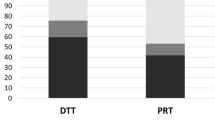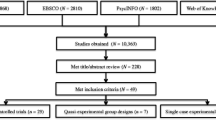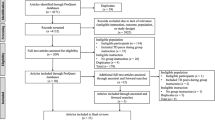Abstract
In this chapter we examine the treatment strategies used in the G-ESDM to facilitate learning. These encompass evidence-based techniques based on applied behavioral analysis and developmentally-based strategies to support the child’s ability and motivation to learn during group routines and play activities. The G-ESDM fidelity tool can be used to facilitate acquisition of the instructional techniques, by providing initial guidance on the skills to learn and ongoing monitoring to determine the level of mastery of the program.
Access this chapter
Tax calculation will be finalised at checkout
Purchases are for personal use only
Similar content being viewed by others
Notes
- 1.
This is an area where the ESDM differs from some other behavioral programs, which are often based on a ‘most to least’ prompt hierarchy.
References
Akhtar, N., & Tomasello, M. (2000). The social nature of words and word learning. In R. M. Golinkoff & K. Hirsh-Pasek (Eds.), Becoming a word learner: A debate on lexical acquisition (pp. 115–135). Oxford University Press.
Baranek, G. T., Little, L. M., Diane Parham, L., Ausderau, K. K., & Sabatos‐DeVito, M. G. (2014). Sensory features in autism spectrum disorders (4th ed.). Handbook of autism and pervasive developmental disorders.
Baron, M. G., Groden, J., Groden, G., & Lipsitt, L. P. (2006). Stress and coping in autism. New York: Oxford University Press.
Doehring, P., Reichow, B., Palka, T., Phillips, C., & Hagopian, L. (2014). Behavioral approaches to managing severe problem behaviors in children with autism spectrum and related developmental disorders: a descriptive analysis. Child and Adolescent Psychiatric Clinics of North America, 23(1), 25–40.
Miltenberger, R. (1997). Behavior modification: Principles and procedures. Pacific Grove, CA: Brooks/Cole.
Koegel, R. L., Koegel, L. K., & Schreibman, L. (1991). Assessing and training parents in teaching pivotal behaviors. In R. J. Prinz (Ed.), Advances in behavioral assessment of children and families (Vol. 5, pp. 65–82). London: Jessica Kingsley.
Koegel, R. L., Schreibman, L., Good, A. B., Cerniglia, L., Murphy, C., & Koegel, L. K. (1989). How to teach pivotal behaviors to autistic children. Santa Barbara: University of California.
Koegel, L. K., Ashbaugh, K., & Koegel, R. L. (2016). Pivotal response treatment. In Early intervention for young children with autism spectrum disorder (pp. 85–112). Springer International Publishing.
Lane, A. E., Molloy, C. A., & Bishop, S. L. (2014). Classification of children with autism spectrum disorder by sensory subtype: A case for sensory‐based phenotypes. Autism Research, 7(3), 322–333.
Powers, M. D., Palmieri, M. J., D’Eramo, K. S., & Powers, K. M. (2011). Evidence-based treatment of behavioral excesses and deficits for individuals with autism spectrum disorders. In Evidence-based practices and treatments for children with autism (pp. 55–92). Springer US.
Rapin, I., & Dunn, M. (2003). Update on the language disorders of individuals on the autistic spectrum. Brain and Development, 25(3), 166–172.
Ratner, N., & Bruner, J. (1978). Games, social exchange and the acquisition of language. Journal of Child Language, 5(03), 391–401.
Rogers, S. J., & Dawson, G. (2010). Early Start Denver Model for young children with autism: Promoting language, learning, and engagement. NY: Guilford Press.
Symes, M. D., Remington, B., Brown, T., & Hastings, R. P. (2006). Early intensive behavioral intervention for children with autism: Therapists’ perspectives on achieving procedural fidelity. Research in Developmental Disabilities, 27(1), 30–42.
Stahmer, A. C., Rieth, S., Lee, E., Reisinger, E. M., Mandell, D. S., & Connell, J. E. (2015). Training teachers to use evidence-based practice for autism: examining procedural implementation procedures. Psychology in the Schools, 52(2), 181–195.
Uljarević, M., Lane, A., Kelly, A., & Leekam, S. (2016). Sensory subtypes and anxiety in older children and adolescents with autism spectrum disorder. Autism Research.
Wolery, M., Ault, M. J., & Doyle, P. M. (1992). Teaching students with moderate to severe disabilities: Use of response prompting strategies. Longman Publishing Group.
Author information
Authors and Affiliations
Corresponding author
Rights and permissions
Copyright information
© 2017 Springer International Publishing AG
About this chapter
Cite this chapter
Vivanti, G., Feary, J., Duncan, E., Zierhut, C., Dawson, G., Rogers, S.J. (2017). G-ESDM Treatment Strategies. In: Implementing the Group-Based Early Start Denver Model for Preschoolers with Autism. Springer, Cham. https://doi.org/10.1007/978-3-319-49691-7_6
Download citation
DOI: https://doi.org/10.1007/978-3-319-49691-7_6
Published:
Publisher Name: Springer, Cham
Print ISBN: 978-3-319-49690-0
Online ISBN: 978-3-319-49691-7
eBook Packages: Behavioral Science and PsychologyBehavioral Science and Psychology (R0)




